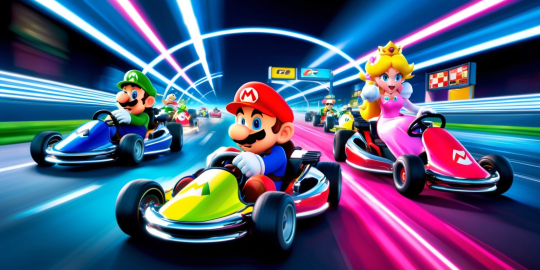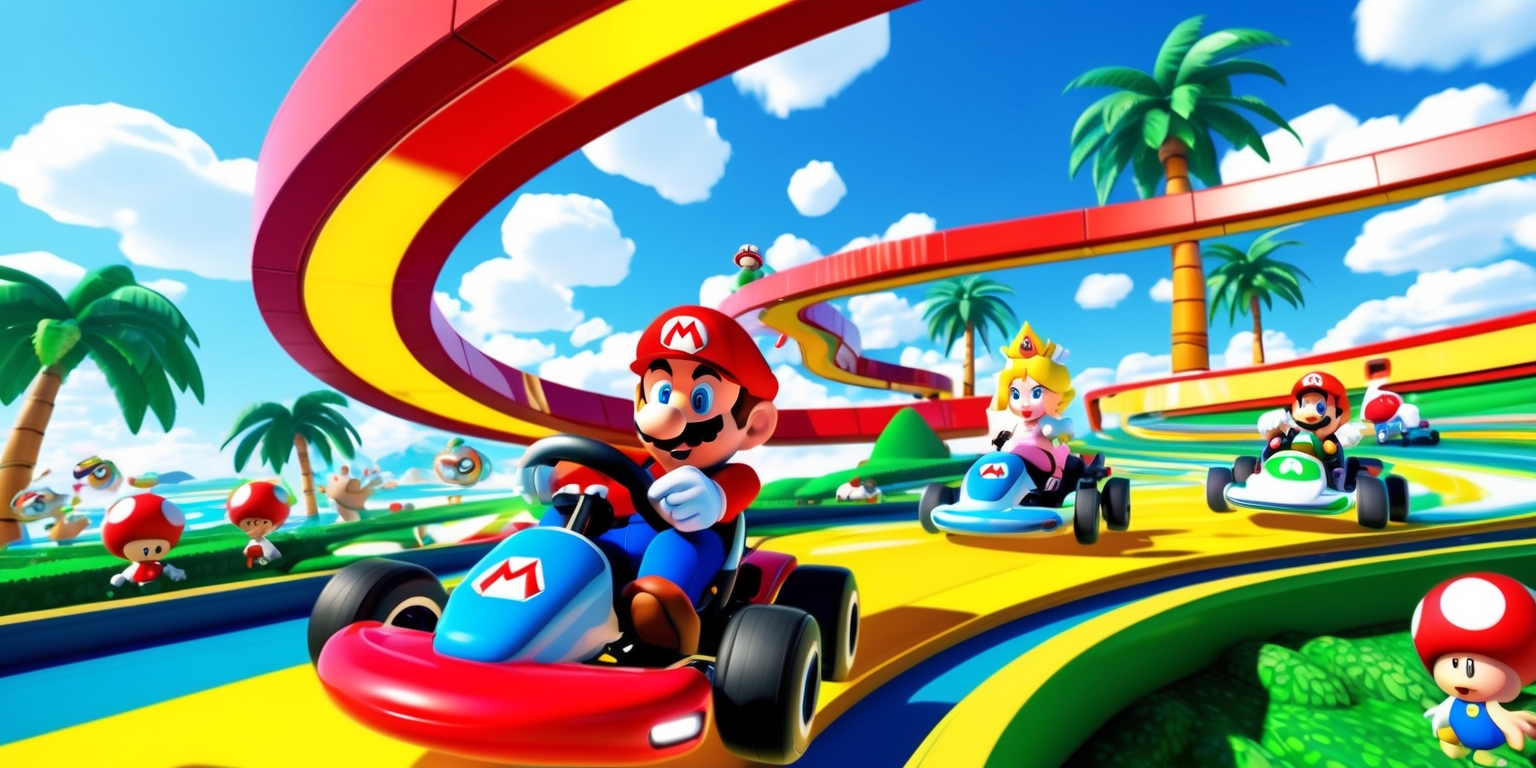
Mario Kart World offers a set of innovative moves that enhance the racing experience, adding depth and strategy to every race. Gamers now have the opportunity to explore detailed mechanics that require both precision and timing. Two key techniques, drifting and charge jumping, form the backbone of competitive play. Both tactics demand an understanding of the kart’s dynamics and environmental cues, blending skill with fast-paced decision-making. The clear visual cues and incremental power boosts ensure that players who invest time in mastering these moves will notice a substantial improvement in their performance on every track. The following sections delve into various aspects of these techniques, examining not only how they work but also how they contribute to "the game's complete visual appeal and practical performance".
Understanding the Drifting Mechanics
Drifting in Mario Kart World is more than just a maneuver; it is an essential part of the racing culture that requires precise timing and confidence. When a racer navigates a tight corner, the act of drifting allows the kart to lean into the turn, creating a controlled slide that maintains speed and balance. The mechanics are straightforward: tilt the left joystick in the desired direction while holding the designated button, and the kart will initiate a dynamic drift with a noticeable lean and skidding motion. Observers will appreciate the colorful trail effects, which progress through different stages to symbolize the power buildup. This mechanism demands focus and provides a blend of visual flair and tactical advantage that is central to success on both casual and competitive tracks.
Exploring the Charge Jump Technique
The charge jump is a recent addition that enriches the Mario Kart World experience by offering an alternative boost method. Designed for straightaways, this move differs from drifting by focusing on a sudden, controlled hop that leverages torques to maximize speed without significant directional change. To initiate a charge jump, simply hold down the same button used for drifting while keeping the left joystick steady, allowing the kart to perform a slight aerial maneuver. The visual representation includes subtle shifts in the kart’s interaction with the ground, showcasing tire friction effects and a brief heel dig that hints at the impending acceleration. While Although it might seem daunting initially, achieving proficiency in this area is entirely within your reach technique opens up new avenues for strategy, especially on tracks where long, straight runs dominate.
Negotiating Corners with Advanced Drifting Skills
When approaching corners at high speed, players have the challenge of balancing precision and power. Advanced drifting techniques allow racers to navigate tight bends while maintaining momentum and preparing for the next straight. The key is not only to initiate the drift properly but also to adjust the degree of the turn by carefully modulating the left joystick. This adjustment is evident through a graduated color change in the tire effects, signaling the evolution from a standard boost to more potent versions. With practice, players develop the ability to choose the ideal moment to release the drift, timing it perfectly for the turbo boost. This aspect deeply interweaves with the aesthetics of the game, where fluid, controlled motion becomes a visual celebration of skillful racing.
Applying Charge Jumps on Open Roads

Open straight sections of a track present a prime opportunity to utilize charge jumps, a technique that emphasizes speed and precision on less curved paths. Unlike the nuanced control required during drifting, the charge jump is more straightforward but demands careful planning. Maintaining a fixed course is crucial since any deviation may affect the kart's controlled hop and subsequent acceleration. As players hold down the designated button during the run, the techniques exhibit familiar color transitions indicative of the boost level. The gradual confirmation of the trick through visual signals is both rewarding and indicative of precision. In these moments, the game transforms into a test of steady control and timing, reflecting the dual nature of Mario Kart World where both finesse and force play equally significant roles.
The Visual Symphony of Turbo Boost Effects
Among Mario's most captivating features is Feel free to adjust the sentence further if needed to ensure it fits perfectly with your overall context Kart World is the intricate visual feedback provided during turbo boosts. As players drift or perform a charge jump, the kart emits vibrant, evolving trails that serve as both a visual indicator of speed and a reward for precision. These color effects progress from a subtle blue for a standard boost to a richer orange or yellow for a more advanced version, culminating in a dazzling multicolored effect that signifies the highest level of mini turbo boost. The artistry of these animations not only elevates the gameplay but also provides critical insights for players striving to perfect their techniques. This immersive blend of visual cues with mechanical performance creates an environment where every move is both functional and aesthetically pleasing.
Mini Turbo Levels and Their Importance
In Mario Kart World, the mini turbo boost system is central to understanding both drifting and charge jumps. Players benefit from a tiered boost system, where each level provides an incremental improvement in performance. The initial blue level gives a modest speed gain, while subsequent levels in orange/yellow and multicolored sequences offer more substantial boosts. This system encourages consistent practice and skill improvement, as players gradually learn to execute maneuvers that yield the best possible benefits. More than just a racing mechanic, the mini turbo system adds layers of strategic depth; knowing when to convert a simple drift into a full turbo charge can be the difference between trailing behind and taking a commanding lead. The nuanced relationship between technique execution and boost levels invites players to continuously refine their skills throughout each race.
Precision Control and Adaptability in Gameplay
Mastering the sophisticated controls in Mario Kart World is a journey paved with careful adjustments and learning from experience. The game tests a player’s ability to adapt under pressure, where minor miscalculations in drifting or charge jumping can have ripple effects over the duration of the race. The tactile feedback from the controller enhances this learning curve, as each press of the button and tilt of the joystick results in a precise in-game reaction. This level of precision demands a blend of quick reflexes and thoughtful planning. By encouraging players to modulate their movements and control both drift and jump techniques accurately, the game fosters an environment where adaptability isn’t just a bonus—it's a requirement. Each race becomes a masterclass in balancing speed with agility.
Integrating Wall Riding with Existing Techniques
Mario Kart World introduces wall riding as an intriguing addition that complements both drifting and charge jumping. Wall riding involves maintaining close contact with the track’s edges, providing further speed benefits when executed correctly. The technique requires players to balance careful steering with precise control over their kart's momentum. Wall riding is a testament to the game’s layered mechanics, as it relies on the same core principles as drifting—a blend of timing, control, and environmental awareness. New racers find wall riding challenging, but its successful implementation can dramatically change the dynamics of a race. Players must decide when to use drifting to maneuver along curves and when to switch to wall riding to gain extra speed, each choice affecting the overall performance and style of play.
Competitive Racing Dynamics and Technique Integration
In online competitive modes, the integration of advanced techniques such as drifting and charge jumping becomes even more essential. The dynamic environment pits players against opponents who are constantly pushing the limits of their skills. Here, precision timing, mastery of mini turbo boosts, and strategic execution underpin every overtaking maneuver. Each racer must remain alert, monitoring both the track and the behavior of competitors, as a well-timed drift or jump can create opportunities to gain an edge. Since these techniques require a continuous interplay of planning and reaction, they increase the overall intensity of the race. The seamless integration of these mechanics with the competitive framework enriches the gameplay experience, emphasizing that superior technique can be as decisive as any in-game item or inherent kart attribute.
Striking the Balance Between Risk and Reward
Every advanced technique in Mario Kart World, whether it is drifting, charge jumping, or wall riding, comes with its inherent trade-offs. The balancing act between risk and reward is evident as players decide which technique fits the situation best. For instance, while the charge jump offers a potent boost on straight roads, it imposes limitations on directional adjustments, potentially exposing the racer to unforeseen obstacles. Conversely, a well-executed drift around a corner not only preserves speed but also prepares the field for subsequent acceleration boosts. The design encourages players to assess each segment of the track carefully, weighing both immediate gains and potential vulnerabilities. This intricate balance challenges players to develop their own racing styles and adapt their techniques on the fly, transforming every race into a strategic contest of precision and timing.